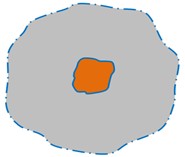India will be the one of the last major countries in the world to experience the urbanization of its population. In 2001, 28 per cent of India's people lived in its cities. By 2040, this is expected to rise to 40 per cent. This means that an additional 300 million people - approximately equal to the current population of the United States - will call urban India home.
The immense scale of this urban demographic shift also means that Indian cities will expand physically - by 200 to 400 per cent in area over the next two decades. This spatial expansion is inevitable. The question is: can we limit it to 200 per cent, or will we repeat the urbanization process seen in the majority of world cities, and expand by 400 per cent? And what is the role of urban transport in deciding the answer to this question?
The city of Ahmedabad is projected to grow from 5.4 million people in 2001 to 13.2 million in 2041. The illustration shown below presents results from an analysis measuring the impact of the eventual area of the city on externalities from urban transport. Two different scenarios are presented. The first one, called "automobility", envisioned a future of low density sprawl where private motor vehicles are the chief means of transport. In the second scenario, called "sustainable transport", a denser cityscape made possible by high quality public transport was assumed.
From a sustainability standpoint, the advantages of the latter over the former are clear, as depicted in the figure. The "automobility" scenario experienced negative externalities an order of magnitude higher that the "sustainable transport" scenario.
| Today | 2041 | ||
| Automobility | Sustainable Transport | ||

|

|

|
|
|
Population
(millions) |
5.4 | 13.2 | 13.2 |
|
Trips (millions/yr) |
5.6 | 39.75 | 39.75 |
|
Area (sq. km.) |
1330 | 6484 | 3242 |
|
Emissions
millions of tons of CO2 / yr) |
0.33 | 12.32 | 1.97 |
|
Traffic fatalities
(per yr) |
175 | 5,232 | 1,225 |
The question really is - can lots of high quality public transport help achieve a compact city? We at EMBARQ India strongly believe in the idea of a Transit Metropolis. There are a number of reasons for this.
Timely and intelligent investments in high quality public transport can be a strong driver for more compact urban forms in India. High quality public transport reduces the need for private vehicle use, thereby reducing the land needed for wide roads and parking lots. High quality public transport also promotes compact development. In turn, compact development leads to more walking and cycling as shops and recreational facilities are closer together, eliminating motorized trips. And even those who continue to drive do so for shorter distances.

•
The first true BRT in India
•
From busway to BRT
•
Look who's on the road
•
Driving cars away
While it remains to be seen if the BRT alone can achieve the scale of impact assumed in the "sustainable transport" scenario above, having such a large public transport network will ensure that the "automobility" scenario is never reached.
The majority of other countries in the world, both developing and developed, have already experienced the urban demographic shift. Brazil's cities, for example, are home to 82 per cent of the country's population. In Mexico, the figure is 77 per cent. For these and other countries, the shapes and spatial dimensions of their urban areas are fully developed, and are here to stay. There is little scope for altering their urban forms as the vast majority of spatial growth has already occurred.
Indian cities now present, not only to India but also to the world, a unique opportunity for capturing impacts on the spatial dimension. As demonstrated in Ahmedabad, building lots of public transport infrastructure can be the driver that captures the scale of impacts necessary to achieve sustainable development.
Transport is not the only driver of this outcome, but it is clearly an important one. If those involved in other domains of planning - land use,
housing, job creation, etc. also were to have a similar focus, then it is quite possible to imagine and shape the metropolises of the future in more
compact, and therefore more sustainable, forms.























